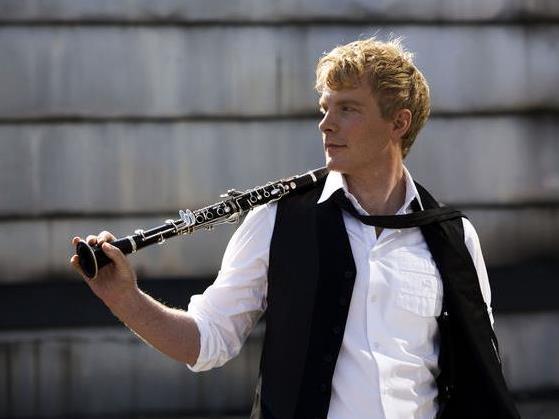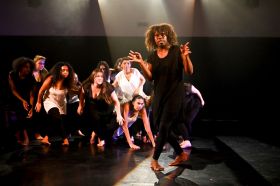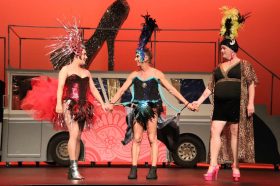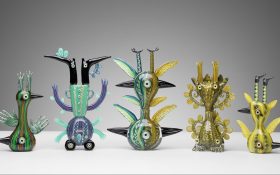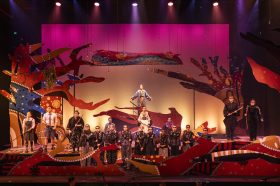Image: Martin Frost. Photo by Mats Backer
Sharing the stage with the Australian Chamber Orchestra was virtuoso clarinettist Martin Frost, introducing a new style of conducting. There were two new works, one of them by the clarinetist’s brother. And there was Mozart – plenty of Mozart!
A strong Nordic connection was enhanced by having the ACO’s Assistant Leader Satu Vänskä leading the ensemble on this occasion. Swede Martin Frost has an international profile, and next year will be artistic director of the Winterfest in Sweden and also holds the post of Artistic Director of the International Chamber Music Festival in Stavanger, Norway.
So perhaps it was fitting that the opening item Was Rautavaara’s A Finnish Myth , a minimalist piece which began with a mood of foreboding thanks to the lower strings creating a chilling atmosphere then giving way to dominance by the violas and cellos. In this and the Denisov’s Paganini Caprice No.9 that followed, the ACO played of course with its customary consummate artistry and control.
There was nothing accustomed however about the next work on the program in which clarinetist Martin Frost appeared to perform the Australian premiere of a work by his brother Goran Frost. DTangled, we were told, started with improvisation. The question was posed: ‘Is not all music quotes?” “And, indeed, who are we?
The program notes proved more helpful. DTangled was born out of an idea to create a fusion between music and movement of the classical music scene. It harnesses Martin’s remarkable combination of talents calling for him to play sing dance and conduct. Because this concept was so new this reviewer found herself concentrating far more on the conductor than the music! The orchestra was drawn into the mood so that at one point the cellists were at 45° angles to their chairs.
The music was at one stage like jazz, at another ethereal, possibly even other-worldly. But by far the greater interest was in the clarinettist/conductor/dancer at the front of the stage. As he swayed, kicked his feet and moved his clarinet we could see that this enhanced conducting might have something to recommend it. We were, in short, charmed.
Next it was a leap back to the familiar … Mozart, and his Symphony No 21 in A K134. The first movement is sunny with bassoon flutes and horn helping to produce a delicate but warm sound. This is perfect fare for a strings dominated ensemble, with violins having several roles even in the andante, and a minuet infused with charm. The final allegro achieved strong dynamic contrasts in a performance that was classic ACO.
After interval we again enjoyed a balance of contemporary and classical music. The first work was commissioned by the family of the late Paddy Pallin. Never truly lost by Brenton Broadstock was, in the composer’s own words, “a journey through an imaginary landscape and (an) imaginary bushwalk”. The solo violin is the walker, a very spare violin as played delicately by Satu Vänskä. This is a work in which one hears what one wants to hear (I thought I heard birds twittering in the auditorium!). It was a peaceful walk but one that was not without sadness as it moved to its thoughtful slow ending.
Never truly lost was well received by the audience who were gratified that the composer Brenton Broadstock was in the auditorium and came on stage for well deserved applause. Next came applause for Martin Frost as he returned as a soloist in a work that has received its fair share of attention over the centuries – enhanced by its use in the film, Out of Africa and innumerable concert appearances before and since.
This was of course Mozart’s Clarinet Concerto in A. Thanks to Frost’s introducing the concept of choreographed conducting, there was interest in how he would perform this well-loved work. We saw that although he was not conducting on this occasion, Frost is nevertheless moved by whatever music surrounds him.
As Vänskä led the ACO in a fine performance to support the clarinetist, he swayed and moved a little with the music. Soloist and orchestra combined to produce the dynamic contrasts and beautiful phrasing that you’d expect from each, particularly in the beautiful Andante.
Interestingly, though, there was little extraneous movement when Frost was playing his solo part, his stance more confident and relaxed as he simply stood and let the music soak into him. Notable was the clarinetist’s fluid control of the work’s ornamentation and rhythms. As the solo ended you could hear his breath for seconds after the notes had finished.
The final allegro most suited Frost’s responsiveness to music. Towards the end of the movement his desire to move took over – but never at the expense of the sound. His enthusiasm could be seen as a well-deserved tribute to the musicians of the ACO who had complemented his playing, as well as delivering a memorable concert in their own right.
Hamer Hall
17 November
Reviewer: Suzanne Yanko
MOZART Clarinet Concerto in A, K.622
Artists
Australian Chamber Orchestra
Satu Vänskä Lead Violin
